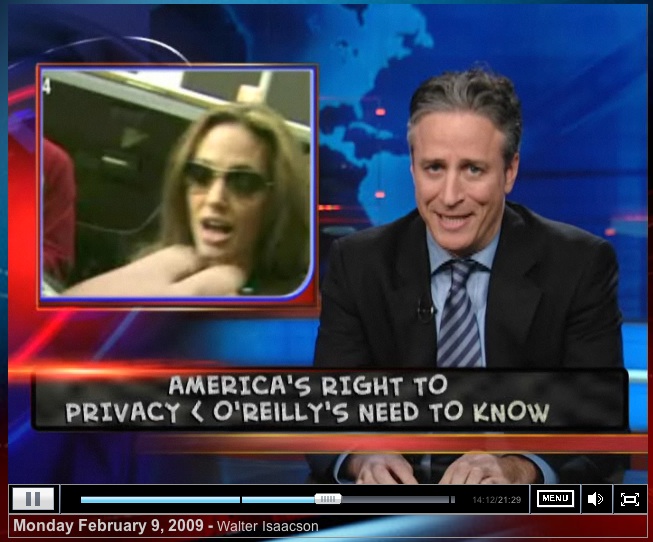An OT analysis from The Daily Show
« previous post | next post »
In the February 9, 2009, broadcast of The Daily Show, Jon Stewart presents a well-argued Optimality Theory analysis of part of Bill O'Reilly's journalistic standards. Stewart and his research team do a good job of gathering and presenting empirical support for a theory involving ranked, violable constraints. Here's a screenshot that links to the full episode:
The crucial cases are Lindsay Lohan, whom O'Reilly has no beefs with, some citizen from the Columbia Journalism Review who is somewhere to the left of O'Reilly politically, and Angelina Jolie, who was like Lohan until she barred O'Reilly from her movie set (or something), at which point she became like the journalism guy.
We can be a little more explicit about the details of the OT analysis. Let's consider the people to be the inputs and O'Reilly's actions relating to them to be the outputs. Then we can use the standard tableau format. Here is the evaluation for the journalism guy:
| Input: Journalism guy | O'Reilly's learns what he "needs" to learn | Privacy |
|---|---|---|
| * | ||
| No ambush | * |
An asterisk means "violation". "O'Reilly's learns …" is ranked above Privacy. Thus, any violation of "O'Reilly's learns …" is decisive. This guy gets ambushed.
Lindsay Lohan vacuously satisfies the "O'Reilly's learns …" constraint, so the lower-ranked constraint Privacy adjudicates, and the No ambush move is the winner:
| Input: Lohan | O'Reilly's learns what he "needs" to learn | Privacy |
|---|---|---|
| Ambush | * | |
In some of the clips inside the Daily Show segment, it sounds like O'Reilly has the constraints ranked the other way, with Privacy winning out in all cases. As is often the case with linguistic analysis, the full range of facts reveals something more complicated.
I strongly suspect that "O'Reilly's learns …" is dominated by other constraints, but The Daily Show's data doesn't contain the crucial cases. Does O'Reilly ever hold back his crew despite a very real need-to-know pressure?
If O'Reilly decides to pursue this research himself, he might title the paper using a quotation from the segment: "Cognitive dissonance and why I don't experience it". The ranking delivers perfectly consistent behavior.
I've skipped lightly over the details of how OT works. OT is mostly used for linguistic analysis, but it has nice applications elsewhere; Elan Dresher's The rise of Optimality Theory in first century Palestine is a good place to go for more details.

Meep said,
February 11, 2009 @ 9:24 pm
The segment didn't make it very clear, but there was an incident when O'Reilly ambushed Obama during the campaign. I'm not sure why that was not included as it perfectly illustrates the disconnect. Perhaps it was because of time restraints? There might be an assumption that the audience is well-versed in the subject's previous transgressions, so given previous knowledge *and* this segment, the conclusion is cognitive dissonance.